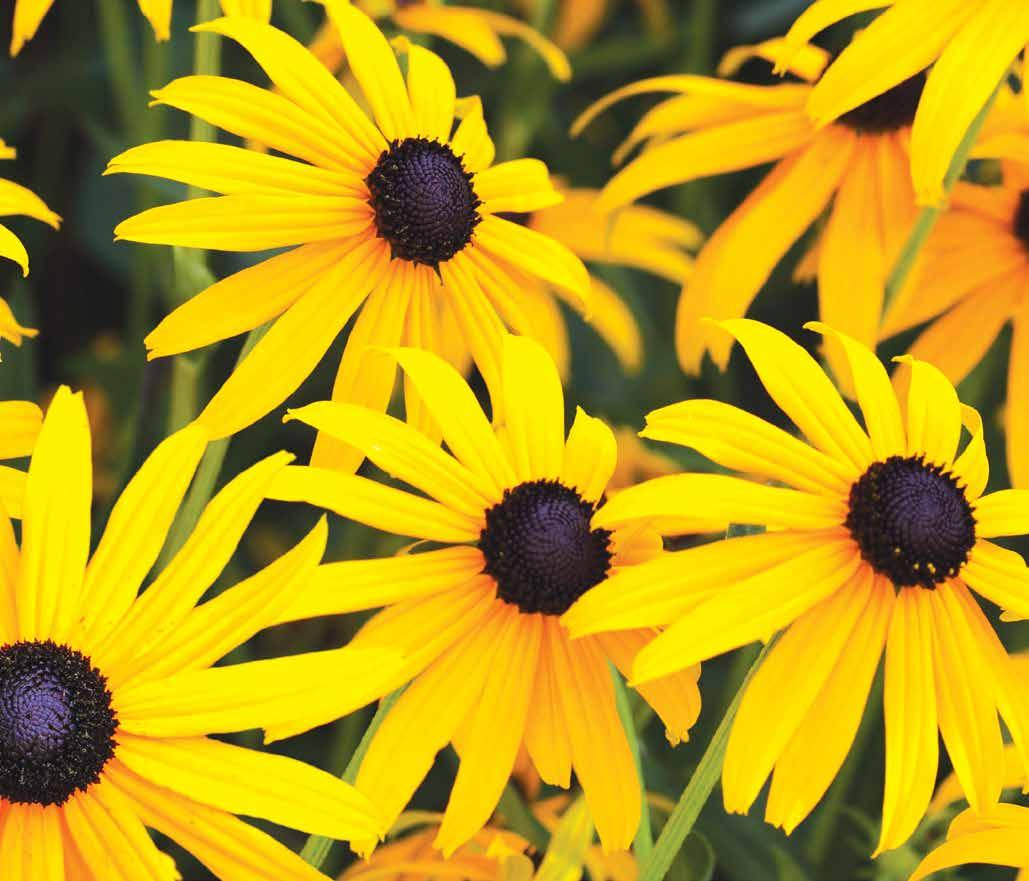

GARDENER
Independently owned and operated since 1996
PUBLISHER
Michael Cavanaugh
EDITOR
Elizabeth Cavanaugh
CONTRIBUTORS
Matt Bunch
Lauren English
Gary Helmers
Markis Hill
Lenora Larson
Sidney Patrick
Anthony Reardon
Elizabeth Stoakes
Scott Woodbury
DISTRIBUTION
IF

IBackyard Sanctuary
t’s a mild summer morning; a nice reprieve from the oppressive heat and humidity that is a Midwest summer. There is a gentle breeze moving from north to south and a few clouds drifting across the sky. Seated in the backyard gazebo, with my cat Louie stretched out, belly exposed, by my side, we are enjoying the sounds of nature.
Heard in the distance, the cardinals announce their territory, and a flock of grackles chatter in treetops. And if I look beyond my immediate space, to the clearing in the sky, I’m able to catch a glimpse of the hawk circling, likely in search of food for the family.
913-648-4728
NEED MORE MAGAZINES? mike@kcgmag.com 913-648-4728
CONTACT US P.O. Box 8725 Prairie Village, KS 66208 913-648-4728
ADVERTISING
Mike Cavanaugh at mike@kcgmag.com 913-648-4728
QUESTIONS ABOUT EDITORIAL AND SUBSCRIPTIONS
Elizabeth Cavanaugh elizabeth@kcgmag.com 913-648-4728
HOW TO SUBSCRIBE
See details on page 23.
WEBSITE kcgmag.com

Of course, resident squirrels race and run, up and down and jumping between trees, ultimately landing on the roof of the neighbor’s metal shed. The ruckus startles Louie enough that a change of position is required. He finds a different chair where the sun peaks through the overhead tree canopy. A nearby barking dog is hushed by its owner, and in the distance you can hear the familiar engine sound of the UPS truck as he makes his way through with deliveries in the neighborhood.
This space we have created is our sanctuary. With the exception of four trees on our property that are more than six decades old, all of the plantings we selected and installed. In the backyard, we are enveloped by columnar evergreens, oakleaf hydrangeas, boxwood, viburnum, and yews. Magnolia, crabapple, and Japanese maple are mature and offer plenty of shade. Gratefully, most are low maintenance once established. In periods of low or no precipitation, we do water to keep our sanctuary thriving. The greenhouse is in the backyard too, where not only is the place to grow lots of edible greens, but it also serves as a respite space in the winter when Mr. Gardener needs a pick-me-up.
This is our place for conversation over coffee or a lunchtime smoothie. It is a quiet space for reflection and serenity, or simply to sit in the sun for a dose of vitamin D.
Indoors is no exception. A few houseplants are situated in the living room for a sense of calm and well-being. Plants indoors also invites a comment from the 4-yearold granddaughter, “Hey Grandad, why do you have a [fig] tree in your
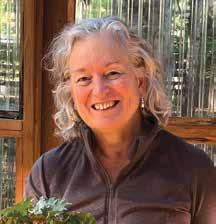
house?” When she is older, and is asked where did her love of gardening originate, she’ll remember her grandfather with a tree in his house, and his greenhouse of carrots to pick. She will tell of his unwavering desire to teach anyone interested about the purity and health of soil, the quality of seed, and the importance of nutrients, water, and sunshine.
This sanctuary, outside and in, likely will be our legacy. Creating space where love, laughter, and happiness grow. I pray the same for you, dear reader.
I’ll see you in the garden!


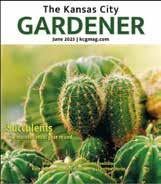






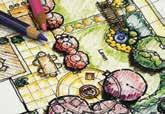











For more information on shows or regular meetings held at the Anita B. Gorman Conservation Center, visit our website www.kcdahlia.org; Or email: greaterkcdahlia@gmail.com.


POND SERVICES
-POND AND WATER FEATURE INSTALLATION
-SERVICE CALLS: LEAK DIAGNOSIS, LIGHTING, PUMP AND AERATION INSTALL -LANDSCAPE LIGHTING: AMP LIFETIME FIXTURES AND TRANSFORMERS -HARDSCAPES: PATIOS, WALLS, FIREPITS, DECKS, AND OUTDOOR LIVING -CLEANOUT AND MAINTENANCE PROGRAMS
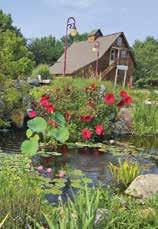
POND AND LAKE MANAGEMENT


Ask the Experts
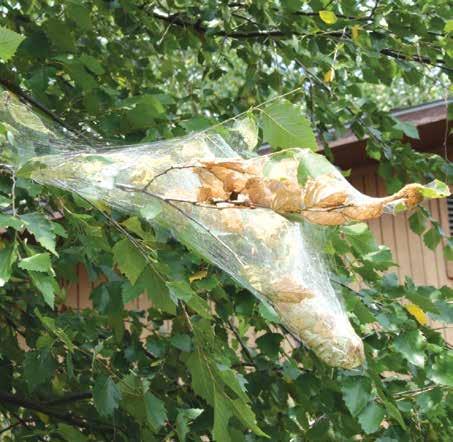
WEBBING IN THE GARDEN
Question: There is webbing all over my flowers, trees, and shrubs. Do spiders cause all these webs?
Markis’ Answer: Not all webs are caused by spiders. Many small species of spiders will produce webs around the tips of some evergreen shrubs. Others will create funnellike, web dens that they can hide in. Signs of spiders include exoskeletons and dead flying insects that look wrapped up in the webs.
If you see webbing in your tree that looks like an impenetrable silk tent that seems to get bigger and bigger by the day, it is a webworm. Two types of webworms are common in

this area: the mimosa webworm and the fall webworm. A colony of fall webworm will swallow up entire branches. These silk tents they create keep them protected from predators, rain, and insecticidal sprays. They have a broad host range, including walnut, cherry, hickory, and birch. In contrast, mimosa webworm feeds on honey locust trees, Kentucky coffee trees, and mimosa trees. The feeding damage will look like folded-over or rolled-up leaves held together by webbing. Leaves will look skeletonized and scorched. Insecticides also have a tough time penetrating the rolled-up webbing and leaves.
Very fine webbing on your pe-
rennial flowers might be the most sinister of them all—spider mites. Two-spotted spider mites will feed on the leaves, leaving small yellow dots where their mouthparts pierce the leaf. Their feeding damage looks rather unsightly and can stunt the growth of plants. In large populations, usually in the hot, dry summer conditions, webbing will appear on leaves where lots of small spider mites can be seen crawling. These pests can be sprayed off using a high-pressure spray of water.
GARDEN WISE HELPS BEAT SUMMER HEAT
Question: Every August, I dread being out in the vegetable garden. It’s hot, humid, and overall, just miserable. Any tips for combating the heat at this time of year?
Anthony’s Answer: With extreme heat, August is common for gardeners to experience “maintenance fatigue,” where everyday garden work falls to the wayside. So, know that you aren’t alone! While we can’t control the weather, a few helpful tidbits can assist in how we address it. Garden-wise, aiming for planting heat and drought-tolerant plant varieties in the spring can be a lifesaver at this time of year, keeping you out of the garden and not nursing plants back to life. Elsewhere, good old-fashioned mulching will assist with keeping the ground cool and moisture in the soil longer. Relegating necessary tasks to early morning or later in the evening will help avoid the worst heat of the day. Watering early in the morning is the recommended practice, as this will allow the most water absorption within the plants, without losing
it to evaporation. Regardless, stay hydrated, wear a hat and sunscreen, and take as many breaks in the shade as necessary!
GARDEN INSECT CURIOSITY
Question: I saw what looked like a wasp flying around carrying a spider. Are they teaming up to scare me to death?
Markis’ Answer: Some wasp species will parasitize spiders, fly them, or carry them back to their nest, and then lay their egg on the spider. Once that egg hatches, the larva will eat the still-alive spider. Several different wasps will parasitize other insects to complete their lifecycle.
HANDLING PRODUCE AFTER HARVEST
Question: With peak summer harvest around the corner, I’m curious about some of the best tips for handling produce after it has been picked. Any pointers here?
Anthony’s Answer: The most crucial factor to remember when harvesting produce is that it is still technically alive, just severed from the sources that keep it healthy. Thus, from the moment of harvest, the clock is ticking on the edibility and longevity of produce. Factors like whether a particular crop should be washed and whether it should be refrigerated or stored on a shelf will vary by every distinct crop, so it’s important to do some research on the various crops you intend to harvest. Remember that ethylene gas, a ripening hormone, is emitted from certain crops, damaging others. These two types should be separated in storage.
ANTHONY REARDON | Horticulture Agents | MARKIS HILL
Anthony and Markis are the horticulture agents for Johnson County K-State Research and Extension, each specializing in edible crops and ornamentals, respectively. For free information fact sheets, visit www.johnson. ksu.edu, or call the Extension office at 913-715-7000.

Fall webworm nest on birch tree.
Photo by Dr. Raymond Cloyd, Kansas State University.
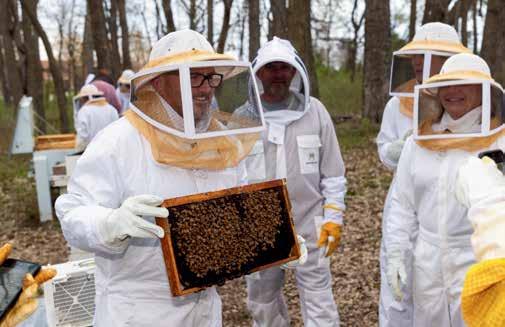

Non-Credit Courses





NOW AVAILABLE AT: Jacksons Greenhouse & Garden Center, Topeka v Doctors At the Lake, Lake of the Ozarks v Manns Lawn
The Healthy Gardener Proper Form in the Garden
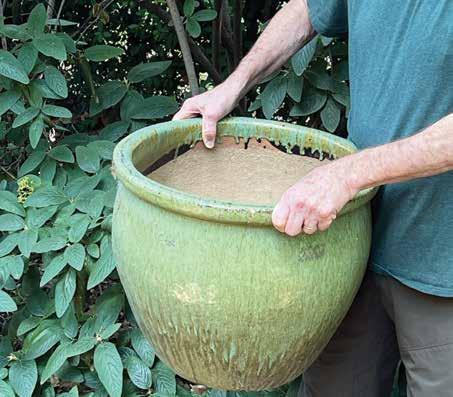
When it comes to gardening, many people don’t realize that it requires a physical effort similar to working out. Whether you’re lifting heavy bags of soil, digging, weeding, or even planting, proper form is essential to prevent injury and maintain long-term health. Like with squats or lifting in the gym, using the correct posture and body mechanics in the garden can keep you strong, balanced, and pain-free, ensuring you can continue enjoying your outdoor activities for years to come.
The Importance of Proper Form
Gardening often involves repetitive movements like bending, twist-

SIDNEY
ing, and lifting, which can put strain on your joints and muscles if done incorrectly. Without proper form, these actions can lead to muscle strains, back pain, and even longterm conditions like arthritis or spinal problems. Just as you wouldn’t lift heavy weights without proper technique, you shouldn’t bend or lift in the garden without considering your body alignment.
Take lifting as an example. Many gardeners routinely lift heavy pots, bags of mulch, or wheelbarrows full of soil. If you use your back to do the lifting, rather than your legs, you’re at risk of injuring your lower back. When lifting in the garden, make sure to squat down by bend-
PATRICK Field Specialist
ing your knees, not your waist. This allows your legs—typically your body’s strongest muscles—to bear the load instead of your back. Keep your back straight and use your core to stabilize your torso. A good rule of thumb is to always keep the object close to your body, as this will minimize the strain on your back.
Common Gardening Movements
Squatting and Kneeling
When planting or weeding, squatting or kneeling is often necessary. While it might feel more natural to bend at the waist, this puts stress on your spine and can lead to discomfort or injury. Instead, squat down by pushing your hips back and keeping your knees in line with your feet. This ensures you’re using your legs to support the action, while keeping your back straight.
If kneeling, try using a gardening pad or knee cushion to protect your joints. If you’re kneeling for long periods, switch positions frequently, and consider using a kneeling bench to provide support for your lower back and hips. Alternating between standing, squatting, and kneeling can help avoid fatigue and strain.
Twisting and Reaching
Gardening often requires twisting to reach for tools, move plants, or adjust objects. Improper twisting, especially when bending, can lead to muscle strains or sprains. Instead of twisting your torso to reach something, turn your whole body by pivoting your feet. This technique keeps your spine aligned
and minimizes risk to your lower back and shoulders.
Maintaining Health for the Long-Term
Proper form isn’t just about avoiding injury in the short term; it’s about protecting your body so you can keep gardening for as long as possible. By using proper posture, you’ll reduce the risk of developing chronic pain, joint issues, or muscle imbalances. Staying injury-free allows you to continue enjoying the physical and mental benefits of gardening—such as improved mood, physical fitness, and stress relief— into your later years.
As you age, maintaining functional strength and mobility becomes increasingly important. Engaging in physical activities like gardening in a way that supports your body will help keep your joints flexible and muscles strong. In turn, this will support your overall health, helping you stay active and independent as you grow older. Taking care of your body while you tend to your garden ensures that you can keep growing beautiful plants and reaping the rewards of your hard work for many years to come.
Keep Moving with MU Extension!
Through Extension, the University of Missouri has many program offerings that safely encourage movements like those discussed above. Visit our website, https:// extension.missouri.edu/events, for up-to-date information about programs near you or join us virtually!
Sidney Patrick is a Field Specialist in Nutrition and Health Education with the University of Missouri Extension. She offers programming related to active aging, healthy eating, and physical activity in the Kansas City area. Email her at spatrick@missouri.edu for more information.

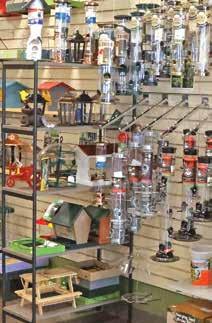





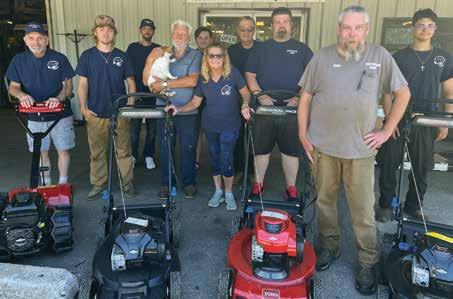
Celebrating 47 years
Prepare the Soil for Overseeding by using Earth Right NOW!


Earth Right opens up hard pan soil so roots can go deeper. Mushroom Stuff expands roots quickly after overseeding or renovating turf!
Root Starter and Enhancer
Covers 20,000 SQ FT

In KC we never know what fall & winter will bring. Protect your lawn & landscape from harsh weather. Use Earth Right prior to seeding to make verticutting so much easier. Apply Mushroom Stuff when grass is up 1/2”.
Serving Kansas City & On the Tobin Family Show for over 30 Years Tobin Lawn & Landscape (816-765-5565)
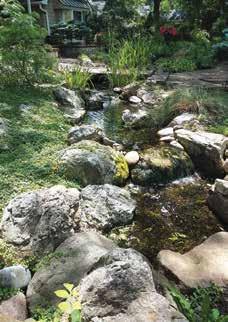
Earth Right 913-492-2992 www.superlawnstuff.com
We have free copies of the Kansas City Favorites magazine available while supplies last, so come pick one up before they are gone!

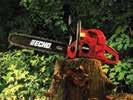



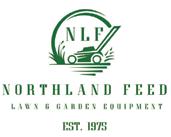
Locally owned & operated by Drew & Megan Diekmann
Ask anyone what makes birds unique, and they frequently respond, “feathers.” These amazing, versatile accessories come in several shapes and sizes to fulfill multiple functions in birds’ lives— from flying and swimming to temperature regulation, breeding or social displays, camouflage, and even as nesting material!
Feathers are composed of keratin, the same as hair and fingernails. Each feather has the same basic structure: a hollow central shaft with smaller branches called barbs, which support rows of even finer branches (barbules). The barbules are securely linked by microscopic hooks, too small to see with the naked eye. This arrangement produces the stiff, lightweight, durable feathers of the wings and tail that allow birds to fly. (For greater stability, some of these are attached directly to bones, by ligaments, rather than skin alone.) Feather structure is maintained by “preening”. Birds use their beaks to stroke individual feathers, smoothing barbs and realigning barbule hooks displaced during flight. Simultaneously, they waterproof themselves by distributing oils from glands at the base of their tails.
Shorter, wider, more flexible feathers, called “contour feathers”, cover and shape most of a bird’s body. These overlap in rows, like shingles. The exposed tips are flattened and waterproof, like flight feathers; barbs at their bases are fluffy and help provide insulation. Muscles beneath the skin elevate and lower these feathers as needed, “puffing up” for warmth or, as in cardinals and blue jays, raising crests on their heads for display purposes.

Fascinating Feathers
Finally, the softest feathers (“semiplumes” and “down”) are worn closest to the skin, where they contain body heat, especially in young birds.
How do feathers acquire the colors we admire so much? Pigments play their part. Black, brown, and reddish-brown shades arise from
orange colors of cardinals, goldfinches, and orioles. Melanin and carotenoid pigments may combine to create intermediate shades, such as olive green.
Structural coloration is the real key to bird beauty. For example, a male Indigo Bunting singing in the summer sun has NO blue pigments

various concentrations of melanin in birds’ skin and feathers. Melanin also strengthens feathers! Scientists have discovered that feathers containing melanin resist wear and tear much better than paler ones. Birds that spend much time flying, such as vultures and gulls, tend to have dark wings or wing tips. Even birds without dark coloring utilize melanin.
Carotenoid pigments, consumed in fruits and other plant parts, produce the vivid red, yellow, and
ELIZABETH STOAKES
ments and blue light reflected from his feathers. A Common Grackle’s head glows with blue or purple hues that change as the bird moves.
Have you ever found a feather and wondered what bird lost it?
Consult The Feather Atlas! Created by the U.S. Fish and Wildlife Service, this site contains photos from
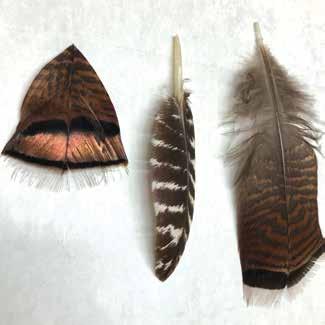
at all! His rich color comes from blue light reflected from air pockets within his feathers, while an underlying layer of melanin absorbs all other colors in the sunlight. Tiny feathers on a male hummingbird’s throat act like prisms, fracturing and scattering light rays to produce his iridescent red gorget (which appears dark in shade). He enhances the flamboyant display by raising these feathers and seeking bright light. A Mallard’s brilliant green head results from a combination of yellow pig-
more than 430 species and has an interactive “Identify My Feather” feature. (Note: it’s illegal to possess any native nongame bird’s feathers without a permit. Study, sketch, and photograph them, but please leave them in the wild.)
Have fun delving deeper into feather facts by visiting these interactive tutorials: “All About Feathers” and “Everything You Need to Know About Feathers” at Cornell University’s website, allaboutbirds. org. Happy Birding!
Elizabeth Stoakes is a past President of Burroughs Audubon Society in Kansas City and has been birding for over 25 years. Please contact BAS via mail@burroughs.org or text/call 816-795-8177 with any birding questions.
Summer Tanager eating his colors.
Body and wing feathers of a wild turkey.
Photo by Terrence Thompson.
Photo by
Elizabeth Stoakes.





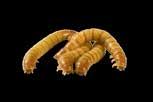




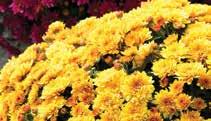


The Greater Kansas City Water Garden Society Presents
2025 Aquatic Frolic Tour


9 a.m. to 5 p.m.
Rain or Shine on the following Saturdays
June 28 Tour #1
Kansas South, I-70 to Louisburg
July 12 Tour #2
Kansas and Missouri North of I-70
July 19 Tour #3
Lawrence, Franklin & Douglas Counties
Aug 2 Tour #4
Jackson County, MO, South of I-70
Aug 9 Tour #5 Cass County
Tickets for all 5 tours are $15. Good for all tour dates and locations. Children under 14 attend free. Purchase tickets through Eventbrite by scanning the QR code, or visit kcwatergardens.com/2025-tour.
More information about the tour is available on the WGS website www.kcwatergardens.com, or on the Water Garden Society of Greater Kansas City Facebook page.


BLUE SPRINGS
Westlake, 1205 N 7 Hwy
Westlake, 918 SW 7 Hwy
BONNER SPRINGS
Westlake, 626 S 130th St
FAIRWAY
Hen House, 2724 W 53rd St
INDEPENDENCE
Westlake, 415 E 24 Hwy
KANSAS CITY, KS
Hen House, 8120 Parallel Pkwy
KANSAS CITY, MO
Planter’s Seed Company, 513 E Walnut
Soil Service Garden Center, 7130 Troost
Suburban L & G, 4 W 135th St
Sutherlands, 311 W 72nd St
Westlake, 1000 Westport Rd
Westlake, 5009 NE Vivion Rd
Westlake, 6201 Independence Ave
Westlake, 104 W 63rd St Westlake, 9715 N Ash Ave
LEAWOOD
Hen House, 11721 Roe Ave
LEE’S SUMMIT
Randy’s Lakeview Nursery, 1820 NE County Park Rd
Westlake, 103 S M-291 Hwy
Westlake, 444 SW Ward Rd
Westlake, 3511 SW Market St
LENEXA
Hen House, 15000 W 87th Pkwy
Suburban L & G, 9275 Dunraven St
Westlake, 15225 W 87th Pkwy
Westlake, 10080 Chestnut St
LIBERTY
Family Tree Nursery, 830 W Liberty
LOUISBURG
Swan’s Water Gardens, 4385 W 247th St
N KANSAS CITY, MO
KC Pond, 1557 Swift
OLATHE
Hen House, 13600 Blackbob Rd
Sutherlands, 16665 W 151st St
Westlake, 1185 W Santa Fe
OVERLAND PARK
Family Tree Nursery, 8424 Farley
Hen House, 11930 College Blvd
Hen House, 6900 W 135th St
Suburban L & G, 10501 Roe Ave
Westlake, 9301 Santa Fe Dr
Westlake, 11200 Antioch Rd
Westlake, 6327 W 119th St
Westlake, 7821 W 151st St
PRAIRIE VILLAGE
Hen House, 4050 W 83rd St
Hen House, 6950 Mission Ln Westlake, 4049 Sommerset
RAYMORE
Creekside Market, 800 E Walnut St
RAYTOWN
Westlake, 10130 E 350 Hwy
SHAWNEE
Earl May Garden Center, 21700 Midland Dr
Family Tree Nursery, 7036 Nieman Rd Westlake, 12230 W 63rd St
SMITHVILLE
Pack’s Hardware, 116 N US Hwy 169
LAWRENCE
Westlake, 601 Kasold Dr
Westlake, 711 W 23rd St
Botanical Dreams, 612 N 2nd St
OTTAWA The Wet Lilies
Summer Pruning which fruit trees and why
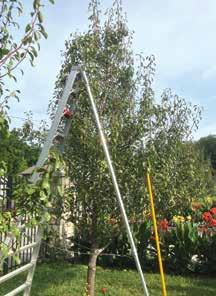
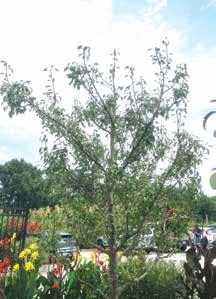
Left to right: Honeysweet European pear before pruning at about 18’ tall with thick interior growth. The central leader, water-sprouts and upright new growth was removed. This was done in August 2024.
If you know anything about fruit trees, and hopefully as you have read this column you now do, it is that they need pruning. Pruning is a maintenance item for all woody plants, shade trees, ornamental trees, shrubs, etc. For fruiting plants this activity can take on added importance, well because these plants produce fruit.
Why prune (fruit) trees
All trees need training and pruning; fruit trees are no exception. Poor branch angles, acute angles under 30 degrees, lead to branch failure on most species. Some species like pears, of which much of this article pertains, are naturally prone to this. Fruit trees also grow very quickly, in some cases 3-8’ of shoot growth a year, growth like this left unchecked

will lead to a messy, crowded, unproductive tree. Trees need to have good airflow and sunlight to allow for blossom formation, and to mitigate fungal pathogens that love to infect fruits in dark crowded canopies. There are also the 4 Ds of pruning: Dead, Diseased, Damaged, and Disoriented; all of these conditions are prevalent in fruit plants
Summer pruning v dormant pruning
There is a lot of discussion on when to prune your fruit trees. Fruit trees definitely need to be pruned during the dormant season, typically for us this is done in February and early March. Dormant season pruning has some real advantages: you can see the structure of the tree, there is no foliage, you can see what you
MATT BUNCH The Giving Grove
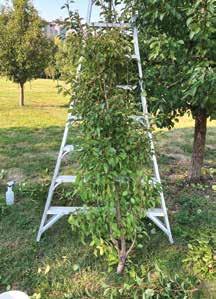
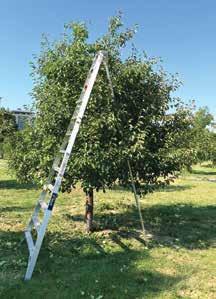
Left: 8’ removed from the central leader of a Potomac pear. Tree is now 14’ tall and easier to thin, spray, prune, and harvest. Right: A 12’ ladder for scale next to an easier to manage tree.
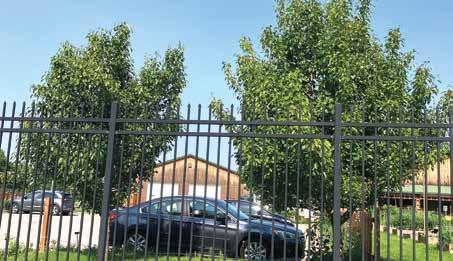
Left tree summer pruned v right not summer pruned. Both trees are the same variety planted at the same time.
are cutting and what you are cutting weighs less; disease and fungal pressure are low to non-existent; new fruit trees really need dormant prun-
ing to promote new growth. Summer pruning is more or less pruning during the warmer months of the year. This needs to happen for a va-
Matt Bunch is The Giving Grove program director for Kansas City Community Gardens and Horticulturist for The Giving Grove’s national network. For more information about Kansas City’s Giving Grove program, visit www.kccg.org/giving-grove.
riety of reasons: raising up sagging limbs; pruning broken limbs; pruning out diseased wood; removing rootstock suckers; and limiting new growth and reducing height, mainly on pears.
Tree physiology
As a general rule for many plants, pruning cuts will stimulate new growth. In the dormant season plant sap is starting to flow upward. The sap is moving up from the roots, stops at the pruning cut, and from there the buds directly below the cut are stimulated, and they break forth into new shoots. These new shoots can then be cultivated into new structural limbs, or fruit producing shoots and spurs. Growth however is rapid and can be erratic. On larger trees, it can be easy to want to make 100 cuts in the dormant season, however 100 cuts may cause 100200 new shoots! Limit those cuts in the dormant season to necessary and larger cuts. Summer pruning is done as sap is reaching a stasis, flowing throughout the plant, and starting to flow back down into the roots. Pruning during this time serves to “devigorate” the plant. New shoots, if they do emerge, will not send out much growth. 5+ year pears and apples are perfect candidates for this type of pruning.
This type of pruning also involves topping the trees. Whoa! Yes I said topping, Certified Arborists are cringing, understandably. Think of this also as limiting the height. Topping is definitely frowned upon for shade and even ornamental trees. Topping on shade trees will lead to new weak growth that will only have to be removed 2-3 years later, unless it breaks first. Fruit trees are different animals, and trees over 15’ can be difficult to spray, thin, harvest etc. Topping cuts are made, typically on pears, by removing some of the central leader (main trunk). X amount of feet are taken out of the top above lateral branch connections. Any upright shoots on those laterals are then shortened so as to not grow above a desired height. 10-13’ is a comfortable height to maintain these trees,
allowing access via pole-pruner, pole picker and 6-8’ orchard ladder. The action of topping is not a “one and done” and will need to happen every summer.
Harvest season can also complicate summer pruning efforts. Luckily many of our Asian and European pear varieties ripen in the same window as summer pruning (late July-
early September). A common practice is to harvest and prune on the same day. Pruning much later than mid-September should be avoided, new pruning cut wounds will not start the healing process before winter. Pruning should also never happen during periods of high disease transmission; this is typically the wetter months of May and June
when temperatures and humidity favor these conditions. So if your fruit trees (mainly pears and apples) are mature and getting too large to maintain, consider a summer pruning regimen.
Need more information on pruning fruit trees in the KC area visit https://kccg.org/fruit-tree-and-bushmaintenance-how-to-videos/.
Foundation First: Test Your S oil
K-State Research and Ex tension/Johnson County
Have you gotten your soil tested recently? Soil test results can answer many of the questions you might have about k eeping our lawn, trees, or flowers in the best-look ing condition The biggest question that of ten gets ask ed is “Should I fer tilize?” O f ten, the answer is “ no ”
The soil might already have the nutrients needed for good plant growth; however, the pH could be either too high or too low, mak ing some of these plant- essential nutrients unavailable for plant uptak e A soil test from Johnson Count y K-State Ex tension will tell you if soil amendments are needed to adjust the pH Don’t guess. Build your lawn and gardens on solid ground-star t with a soil test.
I f more fer tilizer, such as phosphorus and potassium, is added to an area that doesn’t need it, other problems can star t to develop, as well as pollute our local water ways. Garden companies love to recommend balanced fer tilizers for ever y problem you can think of. I n ac tualit y, the more appropriate fer tilizer would be a high-analysis nitrogen fer tilizer
Johnson County residents, get one FREE soil test. (a $20.00 value)


Details revealed from a soil test can var y from one area to the nex t That is why, for the best results, soil samples should be from four or more spots in the area you want to see tested. Get your soil tested. K now exac tly what your soil needs, and what it doesn’t Mak e informed choices, protec t our water, and become the exper t in your own back yard
Before you plant, fer tilize, or treat, star t with the fac ts. A soil test provides essential insight into your soil’s pH and nutrient levels, helping you make informed decisions for healthier plants and more efficient care. Think of it as the blueprint for your lawn and garden success.
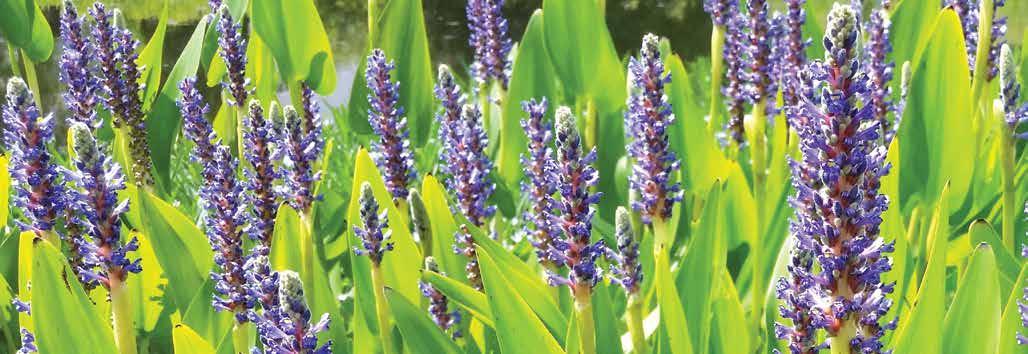
25 Things I Love about Native Plants – Part 2

Some things are worth the trouble. Ponds and water gardens are just such a thing. They attract more wildlife than any other landscape feature, especially dragonflies. Though I don’t have room here to describe the complexities of pond gardening, know that if you introduce a water feature with native emergent aquatic plants like pickerel plant (Pontederia cordata), you will attract dragonflies. They arrive in spring and summer, mate, lay eggs on the water surface, then spend the rest of their adult life lording over your garden. What could be better? They are like silent flying jewels, flitting around from flower to flower, competing with the other dragonflies. What happens to the eggs? They drop to the bottom, morph into a sinister-looking larvae, live there a year, and then emerge the following season by crawling out from the water on a leaf blade, where it then splits open and emerges as an adult dragonfly: beauty from a beast.

In recognition of the 25th anniversary of the Grow Native! native plant marketing and education program of the Missouri Prairie Foundation, veteran native plant horticulturist Scott Woodbury shares insights on some of his favorite native plants. Part 1 was published in the July 2025 issue.
Do you know the kind of native plants that give native landscaping a bad image? The ones that spread around from seed (wildings) and make the yard look more natural. I love those kinds of plants. But they need to be used correctly for the best effect. Unleash any of them in a conventional garden and your workload will increase, as seedlings migrate all over the place. But include them together in a seeded or planted project, keep it weeded for two years, and you will be blown away with an incredibly low-maintenance and beautiful, diverse mosaic garden. Plants that work well for this include foxglove beard tongue (Penstemon digitalis), purple Joe pye (Eutrochium purpureum), Drummond aster (Symphyotrichum drummondii), slender mountain mint (Pycnanthemum tenuifolium), pasture rose (Rosa carolina), purple coneflower (Echinacea purpurea), showy goldenrod (Solidago speciosa), woodland knotweed (Persicaria
virginiana), black-eyed Susan (Rudbeckia hirta), star coreopsis (Coreopsis pubescens), sedges (Carex spp.), bottlebrush grass (Elymus hystrix), hairy mountain mint (Pycnanthemum verticillatum var. pilosum), bee balm (Monarda spp.), skullcap (Scutelaria spp.), Indian plantain (Arnoglossum atriplicifolium), garden phlox (Phlox paniculate), golden Alexander (Zizia aurea), zigzag goldenrod (Solidago flexicaulis), and many more. Check out my howto trampoline garden articles in past issues, numbers one and two. Number three will be coming out later this year. First year it sleeps, then it creeps, and then it leaps.
I love a plant that anybody can grow: a real equalizer. Rose turtlehead (Chelone obliqua) does that. It grows in sun, shade, in wet rain gardens, and can tolerate dry conditions as well. Keep in mind that the more sun you give it, the fuller it will be. In shady gardens, the stems
are more spread out and can colonize with other plants like hop and palm sedge. It comes back year after year, is a long-term performer, and will grow in clay soil.
Tall plants are feared or forgotten in the landscape. The tallest, and my favorite, is hollow-stemmed Joe pye (Eutrochium fistulosum), topping out at 8+ feet. Indian plantain (Arnoglossum atriplicifolium) is similar. Both are whimsical, towering plants that look like an obelisk at Bellefontaine Cemetery, yet are casual, and amateurish, in a good way (I don’t like rules).
September is persimmon harvest season, followed closely by pawpaw harvest season. Both fruits are generally harvested from the ground. Persimmon (Diospyros virginiana) isn’t ripe until the fruits fall from the tree. It’s worth planting a cultivar, as fruits are much larger and therefore more productive for
Scott Woodbury was the horticulturist at Shaw Nature Reserve for 30 years and stepped down from that position in June 2022. He continues to work on contract for Shaw Nature Reserve to carry out native landscaping education and has launched his own business called Cacalia: Native Garden Design and Wilding. Find suppliers of native plants, seeds, and services at the Grow Native! Resource Guide: www.moprairie.org.
Pickerel Plant
Photo by Native Plants Unlimited LLC. 13
SCOTT WOODBURY Horticulturist
food harvest. Pawpaw (Asimina triloba) fruits are usually too high off the ground to reach, and so shaking the trunk will release them when they’re ripe. Watch out—they come down with a thud. A Foley‘s food mill will help you separate persimmon pulp from the seed. Pawpaw pulp is more easily separated by hand. Pulp can be measured out in one or two cup servings and frozen for years. My favorite recipes are pawpaw ice cream (from Bon Appetit magazine) and persimmon pudding (from the Field of Greens cookbook).
I love rock pink (Talinum calycinum), but rarely find a place to grow it successfully. One such place is in a well-drained container, filled with a gravelly soil mix or cactus mix. Another place is in the cracks between a flagstone walkway in full sun. As long as the steps are set in gravel, and not in concrete, you should have success. Plant them randomly along the walkway, and they will seed freely in year two.
Native annuals aren’t used enough, and are barely available commercially. I’ve been begging nurseries to grow native annuals in six packs, so far to no avail. Red whiskers, aka clammyweed (Polanisia dodecandra), is a very showy plant that is easy to grow. It gently spreads around the garden, then comes back year after year, as long as you learn to recognize the seedlings and don’t use a lot of mulch. It is a magnet for clearwing hummingbird moths. Other native annuals worth a try include western wallflower (Erysimuum capitatum), narrow-leaved sneezeweed (Helenium amarum), and palafox (Palafoxia callosa).
Spiderwort seeds resemble the Eye of Horus, an ancient Egyptian symbol representing protection, healing, and regeneration. I love looking at them through a hand lens. Spiderworts are a must in any garden, especially during these uncer-
(continued on page 14)
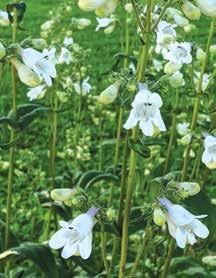
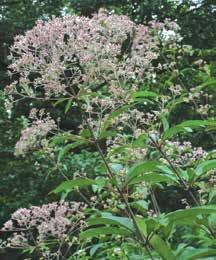
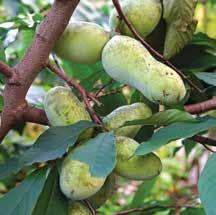
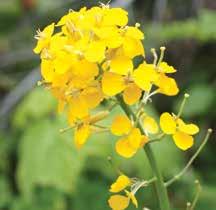
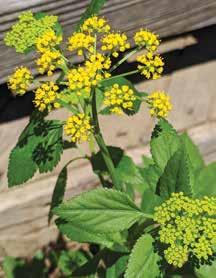
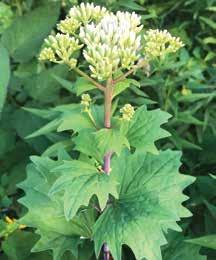
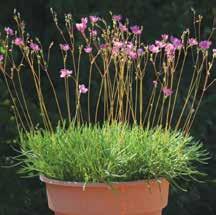
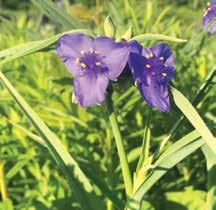
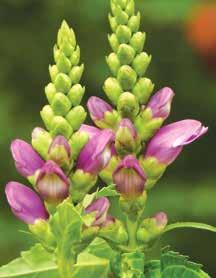
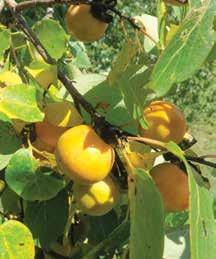
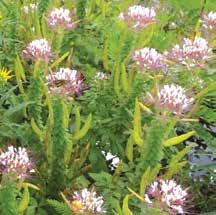
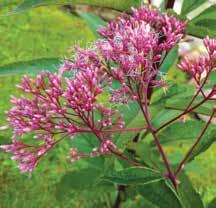
Foxglove 14
Golden Alexander Rose Turtlehead
Joe-Pye Weed
Western Wallflower
Rock Pink Spiderwort
Purple Joe-Pye
Persimmon Tree fruit
Photo by Sow Wild Natives.
Photo by Mervin Wallace.
Photo by Sow Wild Natives.
Photo by Missouri Botanical Garden.
Photo by Roundstone Native Seed.
Pale Indian Plantain 16 17
Photo by Authentic Wisconsin.
Photo by Vinland Valley Nursery.
Pawpaw Tree fruit 17
Photo by TREES.COM.
Photo by Scott Woodbury.
Red Whiskers 19
Photo by NW Wildflowers.
Photo by Authentic Wisconsin.
Photo by Mt. Cuba Center.
25 Things
(continued from page 13)
tain times. If nothing else, you can eat the fresh leaves in a salad, enjoy their cheery spring flowers, and connect with ancient Egypt in the privacy of your own backyard.
When you cut a purple Joe pye (Eutrochium purpureum) stem high in March, it becomes an easy and much-needed nesting site in spring for tiny solitary bees, like sweat bees. Look for little piles of fresh sawdust at the base of the stems and round holes drilled into the center pith of the stem. If you are lucky, you will catch the little bee in the act of laying eggs inside the stem.
I used to hate tent caterpillars that make their silk nest on wild cherry (Prunus serotina) and wild plum (Prunus americana). I would remove them from the tree (if I could reach them) when they
appeared in early spring. But now I absolutely love them because bluegray gnatcatchers gather the silk to line their nests. They also feed the caterpillars to their young. Tent caterpillar nests are considered unsightly, if you use the old playbook for gardening. The new playbook makes room for plants that feed baby birds, in spite of their visual imperfections.
There are few native plants that are both low-growing and coarse in texture. Thankfully there are a number of alumroot species that fit small garden spaces. Prairie alumroot (Heuchera richardsonii) is spring blooming with geraniumshaped leaves. Mapleleaf alumroot (Heuchera villosa) blooms in late summer. I use them in every garden design. In larger gardens, I’ll add them by the dozen, between the showy plants, to fill in blank spaces, and add visual richness. They aren’t the center of attention, but they make other plants in the garden
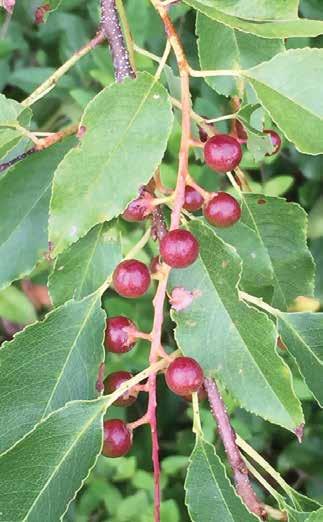
stand out more, thanks to the leaf shape and contrasting texture. I also love the leafless flower spikes of a well-placed cluster of prairie alumroot in April. They add depth and an ethereal quality.
Something that intrigues me is wide color variation of flowers of the same species. It’s true with Bradbury beebalm (Monarda bradburiana), which has different colored flowers depending on the seed strain—some are saturated and almost purple, others rose pink, and still others almost white. Queen-ofthe-prairie (Filipendula rubra) exhibits a range of color and so does rose verbena (Verbena canadensis), little bluestem leaves (Schizachyrium scoparium), spiderworts (Tradescantia spp.), milkweeds (Asclepias spp.) rose turtlehead (Chelone obliqua), garden phlox (Phlox paniculata), blue lobelia (Lobelia siphilitica), blue wild indigo (Baptisia australis), and New England
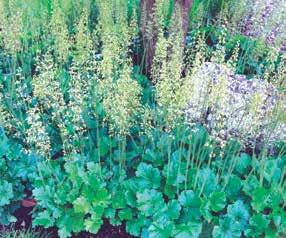
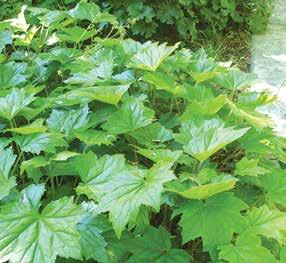
aster (Symphyotrichum novae-angliae). Buying a flat of these is like buying a box of chocolates.
Though this next plant is weedy, I still bring it with me wherever I go. Right now, white sage (Artemisia ludoviciana) lives along the fence on the side of the house, crammed in between other aggressive plants. At the end of summer, I’ll cut the tall stems and bundle them tightly with cotton string. When they dry out, I like lighting them around a campfire to smell the smoke. It’s a sweet and sour fragrance, an incense that humans have smelled and revered for thousands of years. Smells like this instantly transform me to a different place and time, fondly capturing my imagination.
May a few of these plants find their way into your garden, capture your imagination, and follow you wherever you go. Happy 25th Birthday, Grow Native!, and happy gardening y’all.
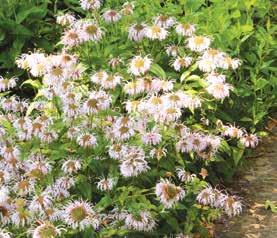

Photo by
Mervin Wallace.
Photo by Scott Woodburry.
Photo by Mervin Wallace.
Prairie Alumroot
Bradbury Beebalm
Photo by Mountain Time Farm.
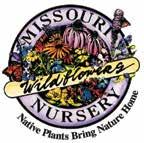
Missouri Wildflowers Nursery
573-496-3492, fax: 573-496-3003
www.mowildflowers.net
mowldflrs@socket.net
9814 Pleasant Hill Rd Jefferson City MO 65109
We’ll be back in September to the KC area for more native plant sales. Watch for more info here, on our website, and social media.
Thank You for using native plants in your landscaping endeavors.
Thank You for helping wildlife through your use of native plants.
Thank You for supporting native plant nurseries with your purchases. It helps them grow.
DAY TRIP! The Nursery is open year round at our Brazito location (address above), 9 to 5 weekdays Weekends now through July 6 and Aug. 30 through Oct. 12. Saturdays 9 to 5, Sundays noon to 5.
At the Nursery only, quart pots are $6.95 and small pots are $3.50, if you pick the plants.
THE METRO’S EXCLUSIVE POND RETAILER
Fish and Pond Supplies for all your water garden needs!
NEW THIS SEASON
Complete Pond Kits for beginners starting at $498.00
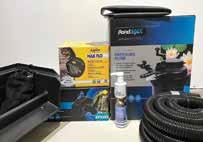
2 sizes easy to assemble
• Small Pond Kit for Goldfish or Planted Water gardens
• Large Kit for Beginner Koi Pond
Includes EVERYTHING you need to build your first pond: Pump, Filters, Liner and Underlayment, Tubing and fittings, Water Conditioner
THIS IS THE TIME TO BUILD YOUR WATER OASIS



Unintentional Butterfly Gardening
The presence of butterfly host plants, the caterpillar’s food, defines a butterfly garden. Sometimes humans unintentionally provide that host plant, which creates an accidental expansion of the butterfly’s range and numbers. For example, botanists theorize that our native paw-paw tree with its delicious fruit was originally confined to the Southeastern U.S. However, indigenous tribes probably carried paw-paw seeds as they migrated towards the Midwest. Zebra Swallowtails benefited and expanded their range to be a common sight wherever paw-paw trees have been spread, including Kansas. The Cabbage White is the most widespread butterfly in North America due in part to our massive plantings of cole crops like cabbage, kale and broccoli.
Accidental Benefits of Carrots
Our native Black Swallowtails are in no danger of extinction and continue to increase in our neighborhoods. Why? Their necessary host plants are members of the carrot (AKA parsley or Apiaceae) family. This includes common herbs like dill, fennel, parsley, cumin, anise, caraway, and cilantro/coriander. (However, no insect eats cilantro leaves since they contain soapytasting aldehydes that repel insects. People with a genetic variation that allows them to taste the soap are also repelled.) Once herb gardeners realize that the colorful striped “parsley worms” are baby butterflies, they are usually willing to share. Identification is easy because no other butterfly caterpillar in our universe eats the Apiaceae, including the similarlooking Monarch caterpillars, which

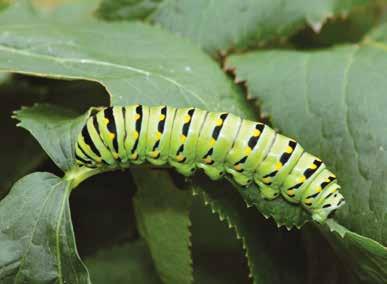
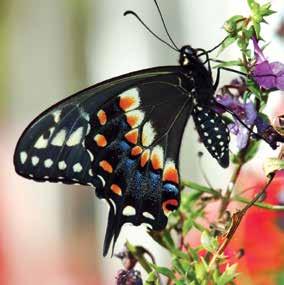
only eat milkweeds. Do you see large black butterflies in your yard?
The female Black Swallowtail adults have black and blue wings, while the males wear black and yellow.
You may not realize that you have planted members of the carrot family, but the Black Swallowtail knows. Butterflies are superb botanists, even though they do not know the Latin names. They identify plants at the molecular level, finding their host plant by smell with olfactory receptors on their antennae. The gravid female then confirms her host plant’s identity by tasting the plant with chemical receptors on her feet before she lays her eggs.
Beyond the Herb Garden
If you grow vegetables, you may also have some Black Swallowtail host plants: obviously carrots, but also celery, Florentine fennel and parsnips. The few scattered caterpillars are rarely sufficiently numerous to threaten your harvest.
You may have included some members of the carrot family as stunning landscape plants. Queen Anne’s lace ‘Dara’ is increasingly popular for its variable shades of pink to maroon blooms on 3-foot stems. I grow fennel for its statuesque feathery beauty at the back of flower beds. This perennial grows four feet wide and up to eight feet tall with soft blue-green foliage and pale-yellow flowers. The cultivar ‘Smoky’ has striking bronze foliage and mustardyellow flowers. My personal favorite landscape plant is the moon carrot, Seseli gummiferum, a recent import from Turkey that has been embraced for its winter-hardy lacy blue foliage and huge white flowers. (Think Queen Anne’s lace on steroids.)
For the native plant collector, most of our native carrot family members are weedy, or deadly poisonous like poison hemlock. Fortunately, the prairie perennial called golden alexanders, Zizia aurea, is so beautiful with its yellow flowers that
I would have it in my garden even if it were not a host plant! However, I rarely find caterpillars munching on my golden alexanders. They consistently prefer the non-native fennel and parsley.
Summary
The relationship may start as an unintended connection between humans and butterflies; however, they can co-exist in beautiful harmony. You could even evolve into an intentional butterfly gardener by adding more hostplants. Just forgo insecticides and grow enough for both of you.
COME SEE MY GARDEN!
Long Lips Farm will be one of five featured gardens on the Miami County Garden Tour September 5 & 6. You will see my 27 acres of habitat surrounding a two-acre English Estate Garden with both ornamental and native host and nectar plants scattered throughout the lush landscape. Handouts will be available to answer your questions. For more information, see our ad on page 15.
Marais des Cygnes Extension Master Gardener, Idalia Butterfly Society and Kansas Native Plant Society member, Lenora Larson gardens and hosts butterflies in the cruel winds and clay soil of Paola, Kansas. She may be contacted at lenora.longlips@gmail.com.
Photos by Lenora Larson.
Adult male Black Swallowtail nectaring on Angelonia.
LENORA LARSON Butterfly Maven
Fifth instar Black Swallowtail caterpillar on a Golden Alexanders leaf.
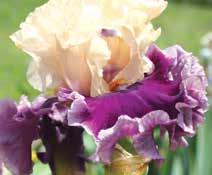


Save the Date!




Select from hundreds of different bare root daylilies with pictures and descriptions
Planting Corner with demonstration, tips, and educational materials
Bargain Table
All plants are from members’ gardens

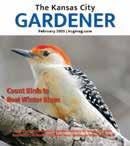


Payment by credit card and cash







At Long Lips Farm, paths provide the design structure for the masses of nectar flowers and butterfly caterpillar host plants.

Kim and Mike’s Floral Haven lives up to its name with containers, cut-flower beds and landscaped areas overflowing with brilliant, fragrant blooms.
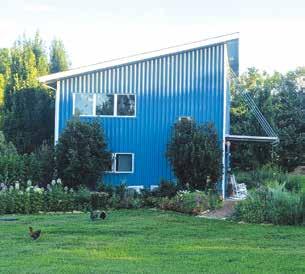
Kristen’s modern “Little House on the Prairie” sits at the edge of a restored 4-acre tallgrass prairie at Prairie Trails.
Miami County Garden Tour, A September to Remember
The Marais des Cygnes District Extension Master Gardeners present our biannual fall garden tour on September 5 & 6. Five country gardens in the Paola and Louisburg areas will demonstrate diverse garden styles and functions. Admission is just $20 per person for both days. Purchase tickets at the K-State Extension Paola office at 913 North Pearl Street before the tour, or at any garden site during the event. Cash or checks accepted. Start your adventure at any garden. Please remember that pets and strollers are not allowed. Happy exploring, rain or shine!
Each garden will also offer garden-related products for sale. Two of the gardens, Mrs. O’s Farm, owned by Texanna Ollenburg, and Long Lips Farm, owned by Lenora Larson, were featured in the July issue. The remaining three gardens are described below.
Prairie Trails: Kristen Dickerson, A Restored Tallgrass Prairie and Native Flower Gardens
As a Kansas Master Naturalist, Kristen is committed to native plants and their ecosystems, including wildlife. In the past three years, the existing tallgrass prairie has been revitalized through a series of controlled burns and the addition of collected and propagated native seeds. She also focuses on eradicating the continually encroaching invasive weeds that would destroy her tallgrass prairie. The house is surrounded by
multiple colorful gardens that combine native and ornamental flowers. The property also includes organic vegetables, herbs and fruits, plus a certified Monarch Waystation and bluebird houses. As an avid birdwatcher, Kristen enhances her ecosystem with paths that weave throughout the prairie for viewing and culminate at a small pond teeming with wildlife. Tour-goers can participate in drawings for gardening gift certificates and an herbal apothecary will be onsite selling her compounded organic products.
Lewis Floral Haven: Kim and Mike Lewis, Flowers Everywhere!
In 2014, Kim and Mike bought four rural acres with a log home and founded Creekside U-Pick, a cut-flower business. The flowers now continue as part of a hobby farm with cutting beds of annuals and mixed floral containers on the porches and patios. The landscape features multiple rows of dahlias, zinnias, sunflowers, lantanas and gladiolas which she hand-waters daily. The blooms attract birds, pollinators and butterflies so hand-picking rather than insecticides controls six-legged pests. A member of the K.C. Dahlia Association, Kim harvests bushels of tubers each fall to share. She overwinters her ferns and cuttings of lantana and coleus indoors in her humid garage/pool house and a newly-built small greenhouse allows early starting of vegetable and flower seedlings. In September, the
sunflowers are magnificent! Kim will be selling her beautiful mixed bouquets to tour visitors.
Three Meadows Farm: Audrey Gabel, Sustainable Homesteading
Audrey has transformed a traditional 60-acre farm into an innovative organic showcase. By transitioning to raised beds and container gardening, weeding has been significantly reduced while the chickens provide pest control. She composts plant debris and her chicken, goose, and horse manure to create the soil in her raised beds and 30 X 72-foot high tunnel. Her rainwater system captures up to 2,000 gallons and uses a pump system for watering the gardens. She also utilizes an innovative organic liquid fertilizer system, the JADAM method. Audrey’s sustainable gardening practices include her growing heirloom seeds for herself and to sell. The landscape beds feature drought-resistant natives interspersed with colorful annuals. Audrey transforms her harvests into handcrafted pickles, jams, vinegars, and skin products, which she will be selling during the tour. An additional vendor will be offering honey and other pollinator products.
For more information, see our ad on page 15. Use the QR Code for a map and addresses. Please visit www.facebook.com/mdcemg or call the Paola Extension Office 913-294-4306 if you need further assistance.
Plant Geek Saturday
For those who love to collect interesting, beautiful plants, Gardeners Connect has created Plant Geek Saturday. Think something like the Kansas City Garden Symposium but entirely focused on the plants for avid gardeners and collectors.
In this, the inaugural year of Gardeners Connect’s Plant Geek Saturday, the focus will be on conifers, woody wonders, climbing and trailing clematis, and a lot of plants that don’t fit in any of those categories. Three plant geek enablers have been invited to entice us with an array of connoisseur plants. Even though some of these plants may seem exotic, they thrive in climates like ours.
Wonders.”
• Clematis expert Deborah Hardwick from central Ohio, discussing “Clematis Myths and Truths” and enticing us with some collectible vines. • Steve Owens, co-owner of Bustani Plant Farm in Stillwell, Okla., encouraging us to “Grow Something Different.”

The Plant Geek Saturday speakers:
• Peter Lowe from The Dawes Arboretum near Columbus, Ohio, talking about “Conifers and Other Woody

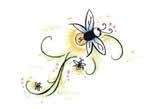
Plant Geek
Saturday is planned from 9:30 a.m. to 3:15 p.m. on Saturday, Sept. 13. The venue will be the same as Kansas City Garden Symposium 2024, St. Ignatius Science Center Room 115 at Rockhurst University. Lunch and morning coffee are included in the ticket price of $99.
Sign up at GardenersConnect.org.
This lecture hall has desks for taking notes. Seating is limited, so get your tickets early.

Festival & Sale


5pm - 11pm each evening
to include Creating a Moon Garden, Gardening for Fireflies, and kids firefly craft activity. See the new glow -in-the-dark Firefly Petunias, and shop the progressive Firefly Sale specials while you enjoy refreshments. Details TBD as of publication time, please call the store, email LBPavlak@gmail.com or see facebook event: “Firefly Festival & Sale!”
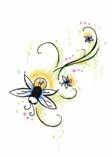






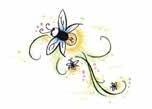

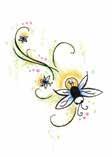




1430 Hwy. 58 LeRoy KS 66857 Lbpavlak@gmail.com. Cell/text: 573-682-7193. Sun. 1-5 pm ~ Follow us on Facebook for all the Latest News & Specials ~


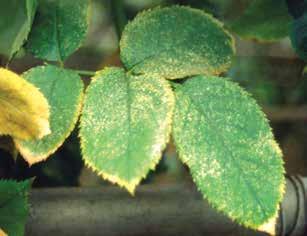
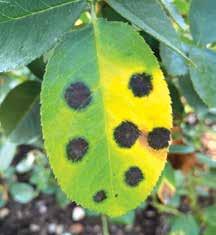
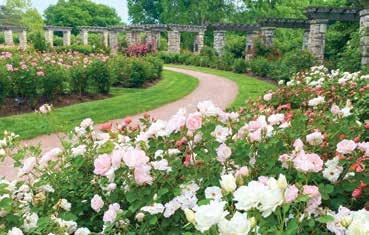
Rose Report August rose care
The forecast for Kansas City metro weather temperatures this month is typical with heat and humidity. Let’s look at what you can do to keep your roses happy and what to do if they are not happy.
• WATER Continue watering your roses twice a week if the temps are consistently in the high eighties and low to midnineties. Avoid overhead watering during this high humidity month, so as not to encourage fungal diseases (see below). Watering at the base of the plant helps prevent disease problems and directs water toward the roots. Think about a drip system next season if you want to reduce hand-watering time.
• FERTILIZE Choose a cooler morning this month and put down your last fertilizer of the season. Remember to never feed your roses if the soil is dry. Water your roses well before fertilizing, then water after fertilization even if you are using liquid fertilizer.

• DEAD HEAD Continue pruning your spent roses through the end of the month to encourage new growth. September can be a beautiful month for roses in KC!
• DISEASES Black spot is the most common fungal disease found in KC on roses, but Cercospora Leaf Spot (CLS) is a hot-season rose disease as well. The symptoms of black spot are brown or black spots with irregular borders. CLS symptoms include purple, maroon, or black lesions that have distinct borders. High humidity favors these diseases. They will produce spores on defoliated foliage lying at the plant’s base, so get rid of all diseased leaves on the rose and in the rose bed.
See https://www.kansascityrosesociety.org/rose-diseases
• PESTS Spider Mites are prevalent in hot, dry weather and difficult to control if they get a foothold. The two-spotted spider mite is the most common
LAUREN ENGLISH Consulting Rosarian
species found on roses. They eat by sucking sap from leaves and other tender parts and can eventually defoliate the plant. If you shake the leaves over a piece of white paper, the tiny spider mites show as small dots. You might see webbing on the underside of the leaf or your leaves may turn a yellowbronze color. You may control a light infestation with a forceful spray of water to the undersides of the leaves three to four times per week. If you have a large infestation, see https://www. kansascityrosesociety.org/ rose-insect-pests for organic or chemical recommendations.
• HEAT TOLERANT ROSES
This is a great time to take a serious stroll around Loose Park’s Laura Conyers Smith Municipal Rose Garden and see what roses are flourishing in the heat and humidity. Hybrid Tea roses ‘Veterans’ Honor’ and ‘Memorial Day’ and shrub roses ‘Morden Blush’ and ‘My Girl’ usu-
ally flourish this time of year at the Rose Garden. See https:// www.kansascityrosesociety.org/ about-the-rose-library. Online companies, such as Heirloom. com, offer a heat tolerant package of roses. You may want to reevaluate your roses for next summer’s heat and humidity!
Please mark your calendar for Kansas City Rose Society’s annual, free Jazz in the Roses concert from 5-7 p.m. on September 7 at the Rose Garden, sponsored by the Fisher Hiles Team (aHiles@reecenichols. com). And, don’t miss the always elegant Kansas City Rose Society’s Wine and Roses fundraiser on September 18. See ticket info at www. kansascityrosesociety.org
Follow us at Kansas City Rose Society on FaceBook or @kansascityrosesociety on Instagram.
You can ask rose questions by clicking on Ask an Expert at www. kansascityrosesociety.org or by emailing our American Rose Society certified Consulting Rosarians at RoseHelp@KCRoseSociety.org
Lauren English is the Kansas City Rose Society Garden Chair at the Laura Conyers Smith Municipal Rose Garden in Loose Park and an American Rose Society Consulting Rosarian. She can be reached at laurenenglish.kcrs@gmail.com.
Morden Blush
Black spot
Twospotted spider mite feeding damage to rose leaves.
Photo by Dr. Raymond Cloyd, Kansas State University.
Upcoming Garden Events
Heartland Hosta & Shade Plant Society
Sat, Sep 13, Hospitality at 9:30a brief meeting, speaker 10a-12p; at the Woods Chapel Community of Christ Church, 500 NE Woods Chapel Rd, Lee’s Summit, MO 64064. Guests are welcome.
Leavenworth County Master Gardeners
Wed, Aug 13, 11a; at Riverfront Community Center, 123 Esplanade St, Leavenworth, KS 66048. Robert Burns of the Northeastern Kansas Beekeepers’ Association (NEKBA) will discuss the basics of beekeeping, bee-friendly gardens and the importance of pollinators in the environment. The meeting is free. Visitors are welcome. For more info contact Leavenworth County Extension office at 913-364-5700.
Leawood Garden Club
Tues, Sep 23, 10:30a; at Cure’ of Ars Catholic Church, 9401 Mission Rd, Leawood, KS. Speaker will be Cameron Kincaid, Senior Manager, GrassPad in Olathe, KS. Topic is “Turf Maintenance in the Fall”. Cameron has been with GrassPad for 22 years, so he knows a lot! We hope you’ll join us. We look forward to seeing our friends and making new ones!
Olathe Garden & Civic Club
Tues, Aug 19, 1-2:30p; at Grace United Methodist Church, 11485 S Ridgeview Rd, Olathe, KS 66061. August Meeting & Floral Design Class **Free & Open to the Public** Join us as we prepare for our annual flower show in September! Featuring floral design instruction from Karen Barnhart, an NGC Floral Arrangement Judge.
Raytown Garden Club
Tues, Aug 5, 10a; at Blue Ridge Presbyterian Church, 6429 Blue Ridge Blvd, Raytown, MO 64133. “Monarch Island: Butterfly Gardening in Parkville,” presented by Laura Fish, Master Gardener and Butterfly Enthusiast. Guests are always welcome. For more information please check out our Facebook page: https://www.facebook.com/RaytownGardenClub.
Firefly Festival & Sale
Aug 1 and 2; 5-11p each evening; at Arnold’s Prairie Greenhouse & More, 1430 Hwy 58, LeRoy, KS 66857. Classes to include Creating a Moon Garden, Gardening for Fireflies, and kids firefly craft activity.
See the new glow-in-the-dark Firefly Petunias, and shop the progressive Firefly Sale specials while you enjoy refreshments. Details TBD as of publication time, please call the store 620-964-2434, email LBPavlak@gmail.com or see Facebook event: “Firefly Festival & Sale!”
Water Garden Society Tour
Aug 2, Aug 9. See our ad on page 9 for details. Also visit kcwatergardens.com/2025tour.
African Violet Display and Sale
Sat, Aug 2, 10a-2p; at West iND Inclusion Center, 10908 Winner Rd, Independence, MO 64052. The Kansas City African Violet Study Group presents a display and sale of African Violets. Come and learn about different varieties of African Violets and how to grow beautiful plants. Event is free. Cash, Venmo or Paypal for sale plants.
Summer Nights in the Greenhouse
Sat, Aug 15; at Vinland Valley, 1606 N 600 Rd, Baldwin City, KS 66006. Join us and stay late for evening shopping, mocktails, and relaxation. vinlandvalleynursery.com; 785-594-2966
Dahlia Shows
Aug 15-16 at Missouri State Fair; Aug 2930 at Powell Gardens; Oct 3-4 at Suburban Lawn & Garden (135th and Wornall Rd, KCMO). Greater Kansas City Dahlia Society. For more information on shows or regular meetings held at Anita B Gorman Conservation Center, visit www.kcdahlia. org; email greaterkcdahlia@gmail.com.
Community Garden Tuesday Talks
Tues, Aug 19, 6:30-7:30p; at Harmon Park, W 77th Pl & Delmar St, Prairie Village, KS 66208. The Prairie Village Community Gardens and the Johnson County K-State Research and Extension Office are partnering to offer a series of monthly educational garden workshops. These sessions will be held on the third Tues of every month from April through Sept. In case of inclement weather, the workshops will take place at the Harmon Park Pavilion. All are welcome to attend these free workshops. Bring your lawn chairs and notebooks!
Volunteers Needed for Garden Cleanups
Sat, Aug 23, 9-11:30a; at Kaw Point Riverfront Park, 1403 Fairfax Trfy, Kansas City, KS. We will supply trash bags but suggest that participants wear their own
work gloves, sturdy shoes or boots, and long pants. We will also be weeding the rain gardens and maintaining the woodland restoration. Questions? Contact us at: friendsofkawpointpark6@gmail.com; kawpointpark.org
GKC Iris Society Plant Sale
Sat, Aug 23, 10a-3p; at Social Hall, Colonial Church of Prairie Village, 7039 Mission Rd, Prairie Village, KS. New and historic varieties of iris grown by local members will be offered for sale. Members will be available to answer questions on growing iris.
Garden Railroad Tour
Sat, Aug 23, 8a-4p. Adults and kids are invited to tour a variety of unique train gardens at homes in the greater Kansas City area. They are like a miniature world with model trains running through garden landscaping, with small houses and buildings, trees, plants, water features, bridges and tunnels. The admission for this self-guided tour is $10 per car which includes seeing all the gardens on tour. The host, MOKAN Garden Railroaders will donate 50 percent of the proceeds to Harvesters. For tickets and tour guide, go to www.mokangardenrailroaders.org.
Miami County Fall Garden Tour
Sep 5-6, 9a-5p. “A September to Remember”, sponsored by the Marais des Cygnes Extension Master Gardeners returns. Five country gardens near Paola and Louisburg are showcased, including a certified butterfly and pollinator garden, a restored prairie, a high tunnel and herb garden, a container and art display, and an extensive cutting garden. The $20 ticket is good for both days and can be purchased at your first garden stop or at the Paola Extension Office. More information will be available on www.facebook.com/mdcemg, www. maraisdescygnes.ksu.edu or call our Paola Extension Office 913-294-4306.
Daylily Sale
Sat, Sep 6, 8:30a-3p (or until sold out); at Loose Park Garden Center, 51st St and Wornall Rd, Kansas City, MO. Select from hundreds of bare root daylilies with pictures and descriptions. Payment by credit card and cash.
Plant Geek Saturday Sat, Sep 13, 9:30a-3:15p; at St Ignatius Science Center Room 115 at Rockhurst University. Lunch and morning coffee are
included in the ticket price of $99. Focus will be on conifers, woody wonders, climbing and trailing clematis, and a lot of plants that don’t fit in any of those categories. 3 speakers. Sign up at gardeners connect.org.
Paula’s Petals Anniversary Lunch
Sat, Sep 13; at Paula’s Petals, 33607 E 199th St, Pleasant Hill, MO. Florist. Greenhouse. Flower farm. The 4th Annual Taco Anniversary Lunch. Join us as we make homemade tacos for the 4th year celebrating Paula’s Petals. Drinks will be available and a dessert. Shop the extensive houseplant collection while you’re here! www.paulas-petals.com, call or text for more information 816-929-0522, or visit us on Facebook.
CLASSES | WORKSHOPS
Growing and Caring for Blueberries
Successfully in Kansas Thurs, Aug 7, 11:30a; at Sunflower Room of the Wyandotte County Extension Office, 1208 N 79th St, Kansas City, KS. Rick Mareske, owner of The Garden at Dogwood Forest, agroforestry expert, and commercial level blueberry producer, will present. Blueberries thrive in more acidic soil than we have in this part of Kansas, yet many of us want to grow them. It is possible to succeed and Rick Mareske will show us how. The class is open to public. Registration is not required. A $10 class fee (cash or check) will be payable at the door. Questions? Call 913-299-9300.
Beekeeping Courses
Starting Aug 20-Oct 1; at Johnson County Community College. Non-credit Life & Leisure courses: Beginner’s Beekeeping; Beekeeping-Exploring the Hive; Beekeeping-How to Keep and manage a hive; Advanced Beekeeping-Pests and diseases; Advanced Beekeeping-Fall and Winter honeybee management. Getting started is easy; just sign-up and show-up! Go to: JCCC.EDU/WDCE. Questions? 913-4692323
List garden events like classes, workshops, club meetings, and plant sales for FREE! Send details to elizabeth@kcgmag.com Deadline for the September issue is August 10.

GARDEN CALENDAR
August list of what to do in the garden.
• Prune and shape hedges.
LAWNS
• Apply about 1 to 1 ½ inches of water per week to Bluegrass to remain spring green.
• Apply about 1 inch of water per week to a tall fescue lawn.
• Apply the last application of fertilizer to Zoysia by mid-month.
• Be on the lookout for grubs and apply proper control methods.
• Plan for fall renovation projects such as aerating and seeding.
• Check the sharpness of the mower blade and repair it.
• Mow turf as needed depending on summer growth.
• Treat unwanted Zoysia and Bermuda grass.
• Take a soil test to determine your fertility program.
FLOWERS
• Apply 1 to 1 ½ inches of water per week to gardens.
• Divide iris and daylilies during the dormant period through early August.
• Make the last application of fertilizer to roses by mid-month.
• Control black spot and other rose diseases.
• Fertilize mums, hardy asters, and other fall-blooming perennials.
• Deadhead annuals to encourage late-season blooms.
• Cut back and fertilize annuals to produce new growth and fall blooms.
• Sow hollyhocks, poppies, and larkspur for spring blooms.
• Prepare for fall bulb planting by making orders or researching varieties.
• Take cuttings from geraniums and begonias for wintering indoors.
TREES AND SHRUBS
• Water young trees every one to two weeks by deeply soaking the root system.

• Check the mulch layer and replenish if needed.
• Prune broken, dead, or crossing limbs for healthier plants.
• Check young trees and shrubs for girdling wires and ropes for planting.
• Avoid fertilizing ornamentals now so they harden off before winter.
• Remove bagworms by handpicking.
VEGETABLES AND FRUITS
• Water about 1 inch per week.
• Plant a fall garden: beets, carrots, beans, and turnips for autumn harvest.
• Plant transplants of broccoli, cauliflower, or cabbage for fall production.
• Harvest crops regularly for season-long production.
• Ease fruit loads on branches by propping them with wooden supports.
• Net ripening fruit to protect from hungry birds.
• Fertilize strawberry bed for flower bud development, improving yields next spring.
• Turn the compost pile and add water when dry.
• Keep weeds under control to reduce problems next year.
HOUSEPLANTS
• Water summered houseplants regularly and fertilize to promote growth.
• Check plants for insects such as scales, aphids, and spider mites.
• Wash plants to remove the dust layer.
• Make cuttings and repot plants before summer sun slips away.
Johnson County K-State Research and Extension recommends environmentally-friendly gardening practices. This starts by identifying and monitoring problems. Cultural practices and controls are the best approach for a healthy garden. If needed, use physical, biological or chemical controls. Always consider the least toxic approach first. Markis Hill is the horticulture agent for Johnson County K-State Research and Extension. For free information fact sheets, visit www.johnson.ksu.edu, or call the Extension office at 913-715-7000.
The Lure of the Daylily
Over the years, I have developed a fondness for this summer bloomer. Some might say it is an obsession, as I grow over 300 daylily varieties in my residential garden.
Looking back, a love of flowers was passed down from my grandmother. I can still see her kneeling on a pillow, arthritis ridden in her 80s, tending her garden.
I was first introduced to Hemerocallis daylily while attending the Northland Garden Club meetings. The club had an excursion to Tom Collier’s garden—he sells daylilies in Lawson, Mo. This is where the obsession was born. Naturally several of his daylilies found their way into my garden.
In 2016 the MoKan Daylily Society hosted a sale, and I found myself surprised. Wow! What a diverse selection of colors, hues, and sizes available for purchase to add to my garden. The members were a fun group and I decided I would become a part of their organization. The rest is history. When I joined I had around 30 varieties. My new found friend at MoKan said wait till the daylily bug bites—it did. I always find room for another in my garden.
Part of the lure of daylilies for me is the wide variety available in the Hemerocallis world. Hybridizers continually tempt gardeners with new varieties.
The length of the daylily season is also enticing. I have daylilies that start blooming in early June, and some that bloom into early September. I have tall ones over 50 inches and short ones under 20 inches. I

Hotlines for Gardeners
Extension Master Gardeners are ready to answer all your gardening questions.
CASS COUNTY
816-380-8194; Wed, 9am-noon; casscomg@gmail.com
DOUGLAS COUNTY
785-843-7058; dgcogardenhotline@gmail.com; Mon, Wed, Fri, 1-4pm
GREATER KANSAS CITY MISSOURI AREA 816-833-8733 (TREE); Mon-Fri, 9am-noon; mggkc.hotline@gmail.com
JOHNSON COUNTY, KS 913-715-7050; Mon-Fri, 9am-4pm; garden.help@jocogov.org
JOHNSON COUNTY, MO 660-747-3193; Wed, 9am-noon
Simmering Elephants
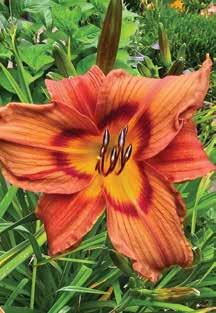
have blooms that are over 12 inches wide cascading down to two inches. Stripes, dots, twists, curls, doubles, fringes, and bicolors—characteristics that add to the allure.
My collection includes a hybrid introduced in 1924, and the latest introduction 2025 purchased at a recent sale. The names are unforgettable. Here are a few examples from my garden: Dance without Pants; Chew Mailpouch Tobacco; Explosion in the Paint Factory; Pumpkin Britches; Spandex; and my favorite, Possum in a D-Cup. The choices seem endless.
Consider checking out the MoKan Daylily Public Sale on Saturday, September 6, at Loose Park Garden Center, 5200 Pennsylvania Ave., Kansas City, MO 64112. Whether you buy one or 20, you won’t leave disappointed!
Oh! Be careful! Watch out for the daylily bug—it just might bite!
GARY HELMERS Daylily Enthusiast
Gary Helmers is a lifetime gardener, and continues to expand his ever-growing collection of daylilies.
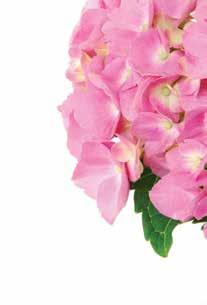
LEAVENWORTH COUNTY 913-364-5700; Leave a message. A Master Gardener will contact you.
MIAMI COUNTY & LINN COUNTY 913-294-4306; Thurs, 8am-noon
WYANDOTTE COUNTY 913-299-9300; Mon-Fri, 9am-4pm
QUESTIONS ABOUT ROSES? Ask a Rosarian; rosehelp@kcrosesociety.org; www.kansascityrosesociety.org
SUBSCRIBE TODAY
For convenient mail delivery, complete the form below and send with your check for $38.00. You will receive a one-year subscription.
Name:
Address: City, State, Zip: Phone:
E-mail: Where did you pick up The Kansas City Gardener?



Please enclose your check payable to The Kansas City Gardener and mail with this form to: P.O. Box 8725, Prairie Village, KS 66208 The Kansas City Gardener is published monthly Jan. through Dec.
Their enormous blooms can’t help but catch the eye from mid-summer through frost.
3 gallon for $34.99
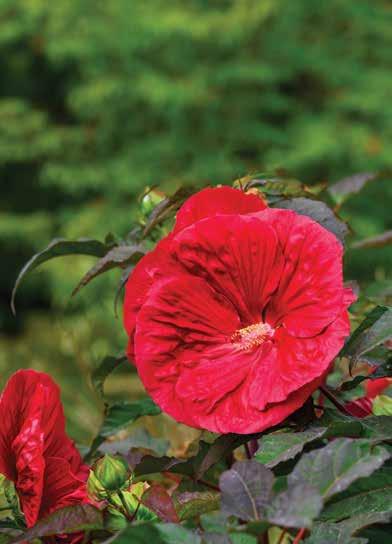
August Shrub Specials
We’re embracing summer with monthly Shrub Specials. Visit Suburbanlg.com for this month’s deals.
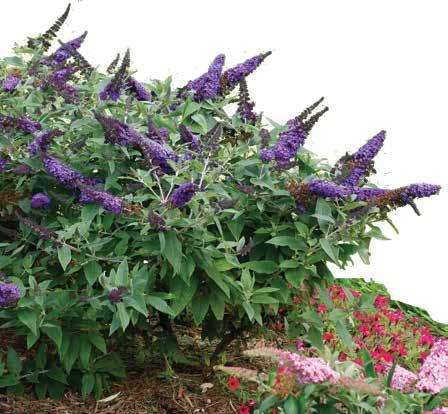
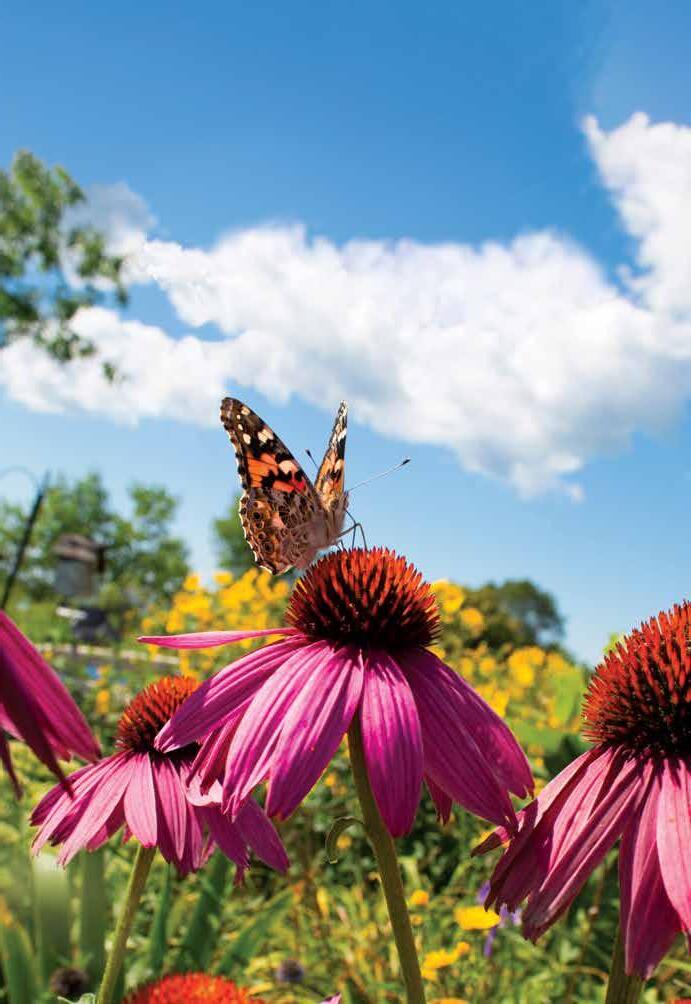
Welcome our butterfly visitors with their favorite nectar-producing perennial blooms like coneflower, black-eyed susan and hardy hibiscus. They’re sure to bring color and joy to your garden summer after summer.
